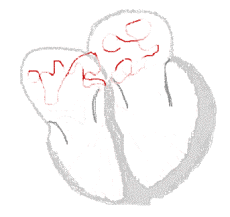Mechanism of development of atrial fibrillation in valvular heart disease
Electrical activity of heart in atrial fibrillation
- Progressive fibrosis of the atria is the underlying pathologic change that results in atrial fibrillation
- Fibrosis of atria can occur due to:
- Atrial dilatation (most common)
- Inflammation
- Genetic causes
- In valvular heart diseases that cause increase in atrial pressure (mitral stenosis, mitral regurgitation, tricuspid regurgitation), there is progressive dilatation of the atria
- Dilatation can also occur due to hypertension or heart failure
How atrial dilatation causes atrial fibrosis?
- Atrial dilatation results in activation of Renin Angiotensin Aldosterone system
- This induces rise in matrix metalloproteinases and disintegrin, which promotes atrial remodelling and fibrosis
How fibrosis of atria results in atrial fibrillation?
- Fibrosis not only involves the muscle mass of the atria, but also involves the conduction system of the heart
- SA node and AV node are affected
- The conduction speed is decreased and multiple foci of electrical activity occur in the atria
- Multiple re-entry loops are setup which results in irregular activation of atrial musculature and atrial fibrillation



